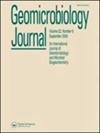青藏高原邻近冰川冰锥孔中的细菌群落
IF 2.2
4区 环境科学与生态学
Q3 ENVIRONMENTAL SCIENCES
引用次数: 0
摘要
摘要冰锥洞是冰川表面的生物热点。低温孢子虫细菌群落在区域尺度上具有强烈的空间异质性,这与环境变量和地理距离密切相关。然而,关于小规模冰锥菌群落的分布模式及其潜在驱动因素的知识仍然有限。在这里,我们使用16S rRNA基因的扩增子测序,调查了青藏高原丹古拉山脉两个相邻冰川DKMD(东克玛迪)和LXZLB(龙下寨龙巴)的冰锥孔中的细菌群落。两座冰川上的冰锥菌具有相似的阿尔法多样性,但群落组成明显不同。地理空间因素是预测两个冰川中冰锥菌β多样性的最重要驱动因素(24.0%的群落变异)。纬度是DKMD冰川细菌群落β多样性的主要驱动因素,而冰锥洞的深度在LXZLB冰川中起着主导作用。总之,这些结果表明,即使在小的局部尺度上,冰锥菌群落也表现出空间异质性,并强调了冰锥孔的形态特性对冰锥菌种群分布的重要性。本文章由计算机程序翻译,如有差异,请以英文原文为准。
Bacterial Communities in Cryoconite Holes of the Adjacent Glaciers on the Tibetan Plateau
Abstract Cryoconite holes are biological hotspots on the glacier surface. Cryoconite bacterial communities are strongly spatially heterogeneous at the regional scale which is closely associated with environmental variables and geographic distance. However, knowledge about the distribution patterns of cryoconite bacterial communities at a small scale and the underlying drivers is still limited. Here, we investigated bacterial communities in cryoconite holes of two adjacent glaciers of Tangula mountain range, DKMD (Dongkemadi) and LXZLB (Longxiazailongba) glacier, on the Tibetan Plateau using amplicon sequencing of the 16S rRNA gene. Cryoconite bacteria on the two glaciers have similar alpha diversity, but significantly different community compositions. Geospatial factors were the most important drivers (24.0% of the community variation) for predicting the cryoconite bacterial beta diversity in both glaciers. Latitude was the primary driver of the beta diversity of bacterial communities in the DKMD glacier, while the depth of the cryoconite holes played a dominant role in the LXZLB glacier. Collectively, these results demonstrated cryoconite bacterial communities exhibited spatial heterogeneity even at the small local scale and highlighted the importance of morphological properties of cryoconite holes instructing the distribution of cryoconite bacterial communities.
求助全文
通过发布文献求助,成功后即可免费获取论文全文。
去求助
来源期刊

Geomicrobiology Journal
环境科学-地球科学综合
CiteScore
4.80
自引率
8.70%
发文量
70
审稿时长
3.3 months
期刊介绍:
Geomicrobiology Journal is a unified vehicle for research and review articles in geomicrobiology and microbial biogeochemistry. One or two special issues devoted to specific geomicrobiological topics are published each year. General articles deal with microbial transformations of geologically important minerals and elements, including those that occur in marine and freshwater environments, soils, mineral deposits and rock formations, and the environmental biogeochemical impact of these transformations. In this context, the functions of Bacteria and Archaea, yeasts, filamentous fungi, micro-algae, protists, and their viruses as geochemical agents are examined.
Articles may stress the nature of specific geologically important microorganisms and their activities, or the environmental and geological consequences of geomicrobiological activity.
The Journal covers an array of topics such as:
microbial weathering;
microbial roles in the formation and degradation of specific minerals;
mineralization of organic matter;
petroleum microbiology;
subsurface microbiology;
biofilm form and function, and other interfacial phenomena of geological importance;
biogeochemical cycling of elements;
isotopic fractionation;
paleomicrobiology.
Applied topics such as bioleaching microbiology, geomicrobiological prospecting, and groundwater pollution microbiology are addressed. New methods and techniques applied in geomicrobiological studies are also considered.
 求助内容:
求助内容: 应助结果提醒方式:
应助结果提醒方式:


